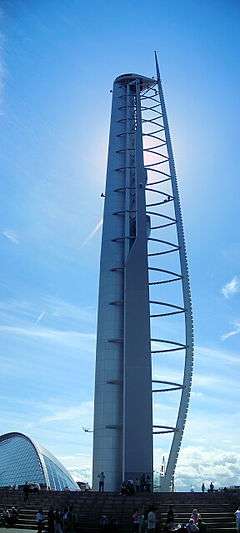Glasgow Tower
| Glasgow Tower | |
|---|---|
 | |
| General information | |
| Type | Observation tower |
| Location | Glasgow, Scotland |
| Coordinates | 55°51′33″N 4°17′46″W / 55.8592°N 4.2961°WCoordinates: 55°51′33″N 4°17′46″W / 55.8592°N 4.2961°W |
| Completed | 2001 |
| Height | |
| Antenna spire | 127 m (417 ft) |
| Design and construction | |
| Architect | Richard Horden |
| Structural engineer | Buro Happold |
Glasgow Tower is a free-standing tower located on the south bank of the River Clyde in Glasgow, Scotland and forms part of Glasgow Science Centre complex. It holds a Guinness World Record for being the tallest tower in the world in which the whole structure is capable of rotating 360 degrees. It has been closed for more than 80% of its life. It re-opened to the general public in July 2014.
Background and world records
At 127 metres (417 ft), the Glasgow Tower is currently the tallest tower in Scotland, and since late 2015 following the demolition of both the Red Road Flats and the Bluevale and Whitevale Towers the structure is now the tallest in all of Glasgow. It holds a Guinness World Record for being the tallest tower in the world in which the whole structure is capable of rotating 360 degrees. The whole structure rests upon a 65-centimetre-diameter (26 in) thrust bearing, and is connected to its foundations by two concentric rings and shock absorbers. The thrust bearing itself rests in a 15-metre-deep (49 ft) caisson. This is to allow the building to rotate under computer control to face into the wind. The tower has two lifts each with a 12-person capacity, but for reasons of comfort, this is normally limited to 6 guests plus a single member of staff. There is also an emergency staircase, comprising 523 stairs from the Cabin level to the Podium.[1]
History
The tower has been plagued by safety and engineering problems throughout its history. It missed its opening date in 2001.[2] Problems with the Nigerian-made thrust bearing on which it rotates led to it being closed between February 2002 and August 2004.[3] On 30 January 2005, ten people were trapped in the lifts and the rescue took over five hours to complete.[4] Following the incident, the tower re-opened on 21 December 2006.[5]
In September 2007, a charity abseil event was held on Glasgow Tower.[6][7]
In August 2010 the tower closed again due to "technical issues stemming from its original design".[2]
As of June 2013 the tower's website states that "at present the Tower is closed to the public due to maintenance and renovation".[8] The Centre states that 65,000 people have climbed the tower during its periods of operation.[2]
The tower opened to the public again in July 2014 with new safety features and an updated interior.[9] The tower now operates annually across the summer months (between April and October) and will take passengers to the observation deck when wind-speeds do not exceed approximately 10 metres per second (36 km/h; 22 mph), which ensures their comfort and enjoyment. However after only three days into operation, a small fire broke out in the lift shaft of the tower caused by faulty cabling. No people were harmed in the incident.[10] The roller bearing was replaced with a ball joint, but the tower is then limited to a few rotations per week. The partial fix was featured in the TV documentary "Incredible Engineering Blunders: Fixed".[11]
Design
It is shaped like an aerofoil (as if an aircraft wing had been set in the ground vertically), with computer-controlled motors to turn it into the wind in order to reduce wind resistance and improve stability through aerodynamic forces (wind split by the aerofoil applies an equal force to both sides of the structure, holding it in place). The tower, previously known as the Millennium Tower, was the winning design in an international competition to design a tower for the city centre of Glasgow.[12] The original architectural design was by the architect Richard Horden, with engineering design by Buro Happold, but after commissioning the project was taken over by the Glasgow architects BDP. In the end the tower cost £10 million. Glasgow Council successfully sued contractors Carillion over the quality of the work.[2]
Tallest building debate

When completed in 2001, it became the second tallest tower in Scotland, behind the Inverkip Power Station chimney. The website for the tower claims it is "The tallest freestanding building in Scotland".[13] Although the tower has an observation deck at 330 feet (100 m),[14] it does not have floors continuously from the ground and therefore the Council on Tall Buildings and Urban Habitat (CTBUH) does not consider it to be a building.
See also
- Portsmouth's stylistically similar Spinnaker Tower, England's tallest building outside London.
References
- ↑ "Flickr photo of World Record certificate". Retrieved 10 November 2007.
- 1 2 3 4 "BBC News - Faulty tower: Glasgow's £10m white elephant". BBC Online. 3 June 2013. Retrieved 3 June 2013.
- ↑ "BBC News Report". 23 August 2004. Retrieved 28 March 2008.
- ↑ "BBC News Report". 30 January 2005. Retrieved 28 March 2008.
- ↑ "BBC News Report". 20 December 2006. Retrieved 28 March 2008.
- ↑ "Glasgow Science Centre webpage on event". Retrieved 26 April 2008.
- ↑ "Cash for Kids charity page". Archived from the original on 14 March 2008. Retrieved 26 April 2008.
- ↑ "Glasgow Tower". Glasgow Science Centre. Retrieved 21 January 2013.
- ↑ http://glasgow.stv.tv/articles/283145-glasgow-tower-set-to-open-to-the-public-for-first-time-in-four-years/
- ↑ http://www.heraldscotland.com/news/home-news/fire-at-glasgow-science-centre-tower.1406060667
- ↑ Incredible Engineering Blunders: Fixed
- ↑ "Horden Cherry Lee Architects". Retrieved 24 July 2007.
- ↑ "Glasgow Tower Facts". Retrieved 28 March 2008.
- ↑ "Science Centre Tower". Emporis (Buildings). Emporis GMBH. 2015. Retrieved 31 August 2015.
External links
- Official website
- Photographs taken from the tower and of the tower
- Online video of the view from the tower
